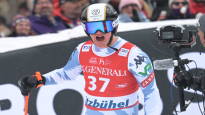Kitzbühel is considered the most beautiful and best competition event in alpine skiing. The municipality has also had a huge prize pool distributed year after year.
The International Skiing Federation demands a prize pool of at least 144,000 Swiss francs (about 152,000 euros) from the organizers of the Alpine Skiing World Cup, such as is offered for example in the Levi slalom competitions.
On the other hand, during the Kitzbühel race weekend, the total prize pool for two downhill races and one slalom is around one million euros. In each of the three competitions, a good 333,000 euros in prize money will be distributed, and the winner will receive 100,000 euros.
No other resort in alpine skiing comes close to Kitzbühel. The next most valuable races are in Zermatt, Switzerland, where the prize pool for one race is 200,000 francs (about 211,000 euros).
Elian Lehto made Finnish history and finished in 11th place in both jumping competitions in Kitzbühel. He received 8,000 euros for both competitions. It was more than three times more than what he had earned in the early season games (4,850 Swiss francs, or about 5,100 euros).
Last season, Lehto got his first World Cup points and with it 1,750 Swiss francs (about 1,850 euros).
French For Cyprien Sarrazin Kitzbühel was a real jackpot, because he won both jumping races and I also won 100,000 euros twice. Sarrazin came second on the list of this season’s top-earning alpine skiers.
Germany won Sunday’s slalom Linus Strasser.
Ladies
1. Mikaela Shiffrin USA 489 00 euros
2. Petra Vlhova SVK 278,000 euros
3. Lara Gut-Behrami SUI 263,500 euros
Gentlemen
1. Marco Odermatt SUI 502,000 euros
2. Cyprien Sarraz’s FRA EUR 364,700
3. Manuel Feller AUT 180,300 euros
– Kitzbühel is the same in alpine skiing as the Monaco GP in formulas. It has become a legendary race. Of course, money is such that it is interesting. Especially in diving, there have been a lot of injuries and many careers have ended in Kitzbühel. That’s why it has become such a legend, Urheilu’s expert Kalle Palander stated in the Sports Studio.
Elian Lehto has also noticed the carnival atmosphere of the Alpine Games in Kitzbühel and the respect shown towards skiers.
– The whole village is full of carnival, so there would definitely be places to party. Here, the skier feels like a rock star when the gang is so excited about alpine skiing and they are in a festive mood anyway, Lehto said after Saturday’s race.
Palander himself won the Kitzbühel slalom twice in his career. At that time, according to his own memory, he received 75,000 euros in prize money per win.
– Back then, in alpine skiing, prize money was distributed only to the 10 best, today it is distributed to the 30 best. It’s a great thing, because money is pretty tight in our sport as well, Palander stated.
The prize money in cross-country skiing is far from alpine skiing
In the Alps, the prize money is on average about three times as much as in cross-country skiing. Whereas the winner of the Alpine Skiing World Cup receives 47,000–60,000 Swiss francs (approximately 49,600–63,300 euros), the victory in the World Cup of Skiing comes with 15,000 Swiss francs (approximately 15,800 euros).
The Tour de Ski was once considered a lucrative tour for skiers, as initially the winner of the Tour received 100,000 Swiss francs (about 105,500 euros), but now the prize pool has been dropped to 80,000 Swiss francs (about 84,400 euros).
Read more: This is how Kerttu Niskanen accumulated his “million account” – one Finnish legend squats even Iivo Niskas dully on his reward pot
In the Tour, only the top three finishers from a single event receive prize money, and the pot is significantly smaller than in a normal World Cup race. You get 3,200 euros for the win, 2,200 euros for the second place and 1,100 euros for the third place. At the end of each day, the leader of the overall race receives an additional bonus of 1,100 euros. The top three finishers in the tour’s points competition also receive prize money.
Kerttu Niskanen earned 49,500 euros at this year’s Tour de Ski, Krista Pärmäkoski around 16,000 euros and Perttu Hyvärinen 5,400 euros.
– In many other areas of life, salaries have gone up. In skiing, it has gone downhill. The prize money has been more or less the same since the 90s. They could be gradually increased, as it would encourage athletes to participate more, Urheilu’s expert Ville Nousiainen stated in the Sports Studio.
Earns the most in biathlon at the World Championships
In biathlon, the winner of the event is paid 15,000 euros, but athletes have the opportunity to earn more from the World Championships. Sports expert Kaisa Mäkäräinen said that, for example, in the upcoming World Championships in Nove Mesto, the International Shooting Sports Union (IBU) will pay 1.5 million euros in prize money. 25,000 euros will be awarded for the world championship.
– When the World Cup was removed from the World Cup a few years ago, they wanted to increase the value of the World Cup so that the prize money was almost doubled compared to the World Cup.
In alpine skiing, the biggest income streams for alpinists usually come from equipment bonuses. According to Palander, ski companies are indeed the biggest payer for many skiers. The situation is different in biathlon and skiing.
– There are bonuses in biathlon if you are in the top three. The prize money paid by the IBU plays a much bigger role for Finnish athletes, Mäkäräinen said.
– If we are talking about the skiers who are not among the top three, then the personal sponsor is usually the biggest payer. Otherwise, the small prize money will bring it a few hundred or tons a year. That’s not enough to pay for that pleasure, Nousiainen stated.
